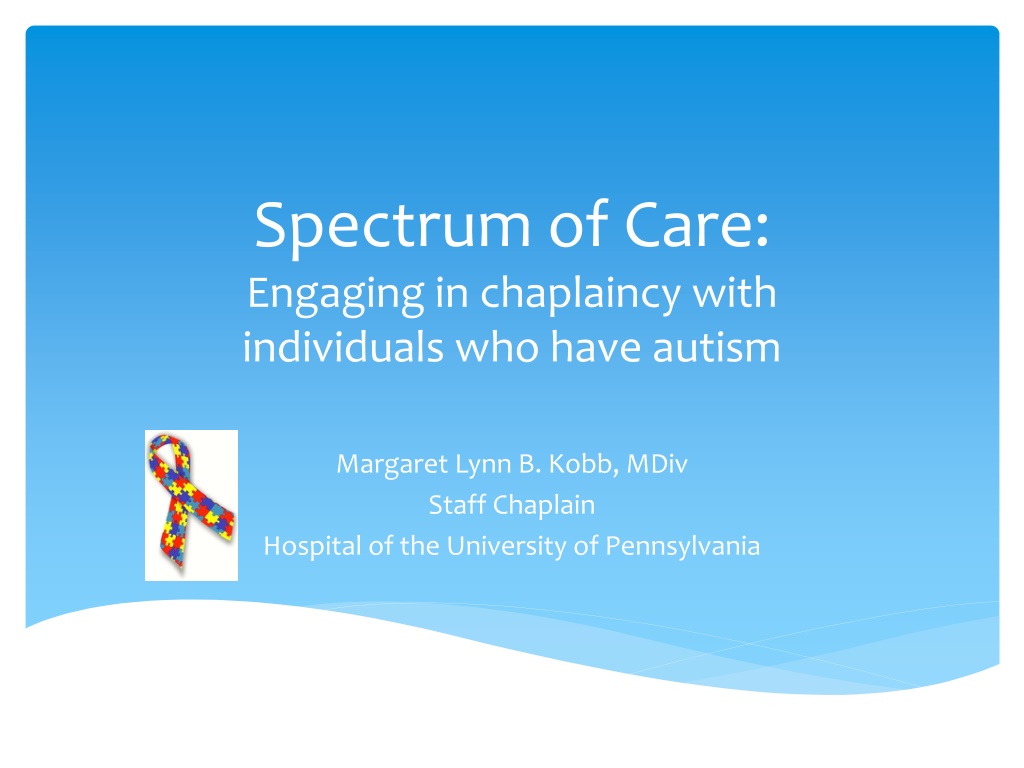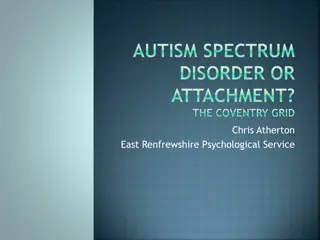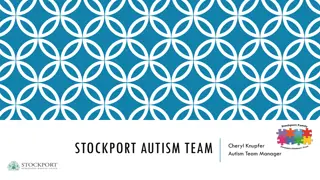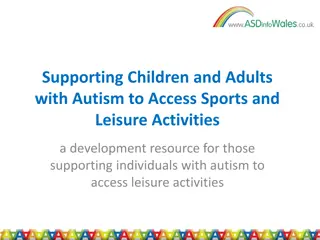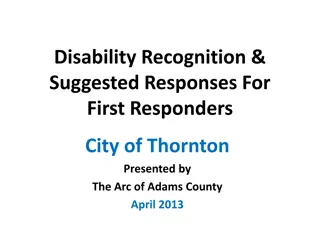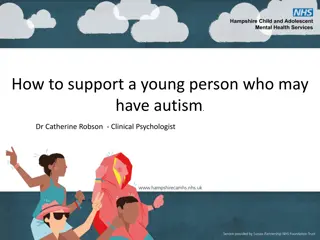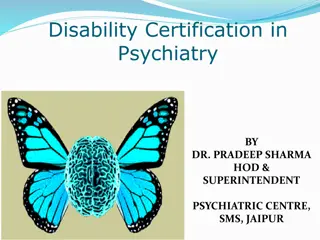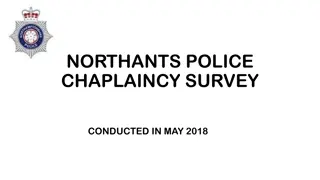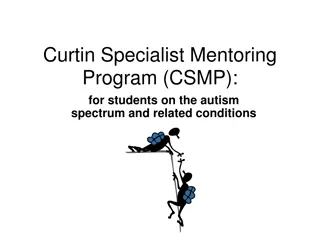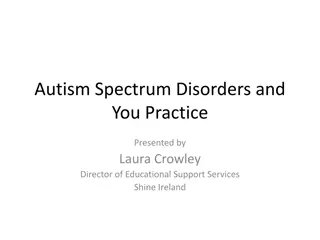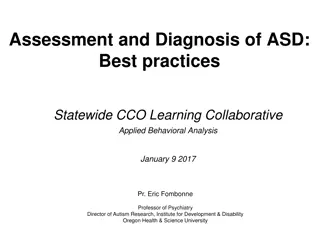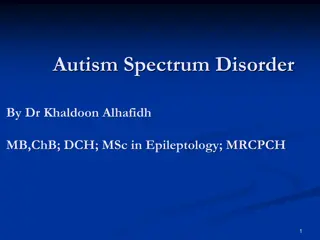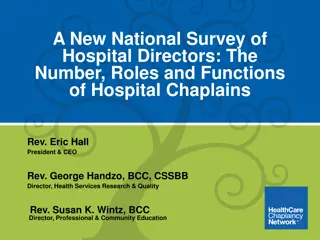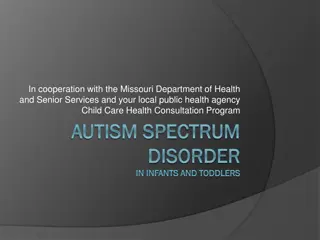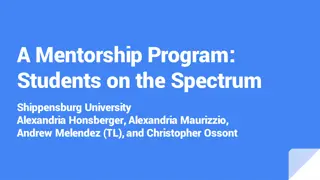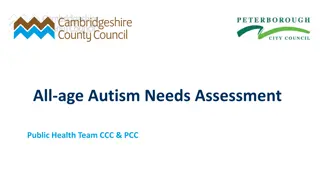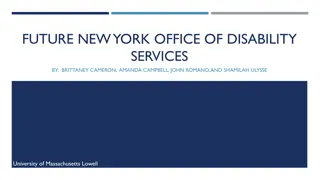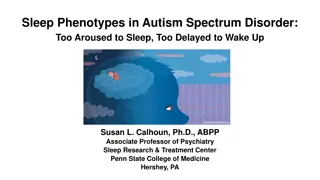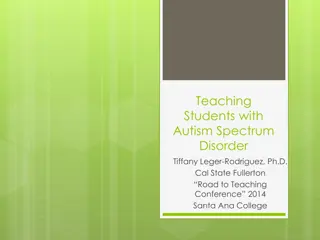Understanding Autism Spectrum Disorder in Chaplaincy Care
This presentation delves into the complexities of engaging with individuals on the autism spectrum within a chaplaincy setting. It covers the essentials of autism, patient and family experiences, practical pastoral care approaches, and case studies. The speaker, a chaplain and autism advocate, emphasizes the importance of her role and personal connection to autism through motherhood. Definitions, DSM-5 criteria, common behaviors, and the impact of autism on communication and social interaction are explored to enhance chaplaincy support for individuals with autism.
Download Presentation

Please find below an Image/Link to download the presentation.
The content on the website is provided AS IS for your information and personal use only. It may not be sold, licensed, or shared on other websites without obtaining consent from the author. Download presentation by click this link. If you encounter any issues during the download, it is possible that the publisher has removed the file from their server.
E N D
Presentation Transcript
Spectrum of Care: Engaging in chaplaincy with individuals who have autism Margaret Lynn B. Kobb, MDiv Staff Chaplain Hospital of the University of Pennsylvania
Objectives What is autism? Vocabulary of the spectrum Experience of patients on the Autism Spectrum Experience of family members Theology of disability Practical approaches in pastoral care Case studies Discussion & questions
Why it matters to me Chaplain, advocate, MOM Being an Autism Mom makes me better at the other two Work locally & nationally with Autism Speaks Blessed to be a blessing
What is autism? Autism is a neurological disorder characterized by deficits in both language and communication.
Autism Spectrum Disorder DSM-5 Classic Autism High-Functioning Autism PDD-NOS (Pervasive Developmental Disorder-Not Otherwise Specified) Childhood Disintegrative Disorder Sensory Processing Disorder Asperger s Disorder Atypical Asperger s Rett s Disorder
DSM-5: Autism Spectrum Disorder Persistent deficits in social communication and social interaction Restricted, repetitive patters of behavior, interests, or activities Symptoms are present in early childhood Symptoms limit or impair everyday functioning or relationships (Tierney, 2015)
Common Behaviors in ASD Decreased eye contact Uneven development of skills Resistance to changes in routine Marked hyperactivity and/or extreme passivity, which may alternate Less demonstration of typical signs of affection Odd body movements or postures (flapping, spinning, etc.) (Challman, 2015)
So what does that look like? Looking down, instead of at you when you speak Not answering questions, or not answering right away Not wanting to be touched Repetitive rocking, swaying or bouncing Walking only on toes Flapping hands Making noises that are not words
Sensory Sensitive Frequently, people on the Autism Spectrum experience sensory input more acutely. Increased sensitivity to heat/cold, light/dark, textures on clothing or surfaces, sound especially loud noises, textures in foods, strong smells Easily overwhelmed or distracted
Sensory Overload https://vimeo.com/103896616
Causes of Autism VACCINES DO NOT CAUSE AUTISM.
The persistent vaccine myth Dr. Andrew Wakefield published a paper in 1998 claiming that the MMR vaccine had caused autism in the children in his study. Sample size = 12 Never replicated Falsified data Soundly rebuked by the medical community And yet the damage was done.
So then what does? Genetic Environmental Gene deletion or mutation About a dozen genes where deletion is involved About two dozen genes were mutation is involved All environmental influences happen in utero: Certain maternal infections Certain toxic exposures (often alcohol) Risk elevated with prematurity
A growing population CDC: 1 in 68 children will be diagnosed with autism Recent government survey has even higher numbers 1 in 45. 2% of the population
Our words matter! Person-centered language: patient with autism not autistic patient On the spectrum Aspie as a self-identifier for many
Normal Normal implies that there is an abnormal. Better choice: neuro-typical Never use retarded. Better choice: developmentally disabled
Experiences of patients on the autism spectrum
Patient Experiences OVERWHELMING! Strangers all around They re touching They re talking Bright lights Siren outside So many needles
Patient Experiences Change in routine Different bed Different food Unfamiliar noises And all of this while you re not feeling well Unsettled & anxious
The challenge of non-verbal patients 1/3 of children and adults with autism are non-verbal. (Autism Speaks) How do you know if your patient is in pain? How do you know if your patient wants to visit? How do you engage in spiritual care with someone with social and language impairments?
Yearning to connect Without fail, parents believed at least one of three things about their children s spiritual lives: that their children had a deep spiritual connection to God; that they had the capacity to develop such a relationship; or that through their active involvement and visible presence in the church community, they could enhance the spiritual lives of the members. (Speraw, 2006)
A Vibrant Spiritual Life We often don t give adolescents, especially those with special needs, enough credit when it comes to spirituality. Because an adolescent has a physical, neurological, or intellectual disability, and can t communicate in our way, we assume a lack of depth or sophistication. A disability, however, does not mean there are limitations in the ability to have a spiritual life. (Spitzer, 2008)
Experiences of family Autism affects the entire family. A diagnosis of autism for one family member will affect the whole family system. (Walsh, 2008)
Unrelenting stress Caregiver stress that lasts a lifetime Nearly of those diagnosed wander, leading to safety worries. 84% of adults with autism live with their parents. (Autism Speaks)
Autism mom vs. soldier Mothers of adolescents and adults with autism experience chronic stress comparable to combat soldiers and struggle with frequent fatigue and work interruptions. These moms also spend significantly more time caregiving than moms of those without disabilities. (Seltzer, 2009)
Fierce advocates Adversity & resilience Frequent exposure to medical professionals Years of experience advocating for their child Weary & wary
Mom/Advocate And I would call, and they d say, We don t treat autism. And I d say, I don t want you to treat autism. I want you to treat my son. --Suzanne Joseph, about her adult son David
Needs unmet Nurses and clergy cannot assume that membership in a faith community automatically brings social support or spiritual well-being. (Speraw, 2006) Experiences of isolation Social stigmas surrounding autism
Duality of experience On the one hand, believing that their child is capable of relationship with a higher power. And yet experiencing isolation & social stigmatization that makes membership in a religious community fraught with difficulty.
Psalm 139:13-14 For you created my inmost being; you knit me together in my mother s womb. I praise you because I am fearfully and wonderfully made; your works are wonderful, I know that full well.
Theology of disability Can we still be fearfully and wonderfully made if we are disabled?
Broken people Old way of thinking: those with disabilities were somehow broken Frequently placed blame on the parents Viewed the disabled as less-than
An important shift My call for defining faith as a gift from God rather than a set of beliefs or a well-developed cognitive understanding of all things spiritual is, then, an attempt to encourage us to take seriously this tension from the grace side of the equation so that children are recognized as fully [spiritual] beings from birth. If we hold this definition of faith as an act of grace, then we make room for children to be actual people of faith rather than just potential people of faith in need of further development before they can truly engage in a spiritual life
An important shift If faith is not something we do but something we are given by God, then anyone can be a recipient of faith and respond with faithfulness, even if that person is incapable of rational reasoning. (Yust, qtd. in Conner 2010)
Changes across denominations Mormon perspective: Individuals with disabilities are entitled to all the blessings that God has in store for His faithful and obedient children. (Nelson, 1998)
Changes across denominations Pope Francis has spoken out several times in recent years about the need for inclusion Met with children on the autism spectrum in 2014 to promote acceptance
Cultural shift Rep. Pete Sessions, congressman from TX I believe Alex was created in God s image. It just took my wife and I a few years to figure that out.
Acceptance & Inclusivity We as chaplains have the opportunity to model that radical acceptance and inclusivity. Each patient, each family member, each experience carries inherent worth and dignity.
Tools we can use Concrete language Don t use 10 words when 4 will do. I m feeling curious about what s going on inside you right now. Better choice: How do you feel?
Tools we can use Prompting It s hard to draw words out of thin air. I feel ______. Identifies & validates
Tools we can use Visual Aids Prayers in written form Point to charts (especially handy for non-verbal patients)
